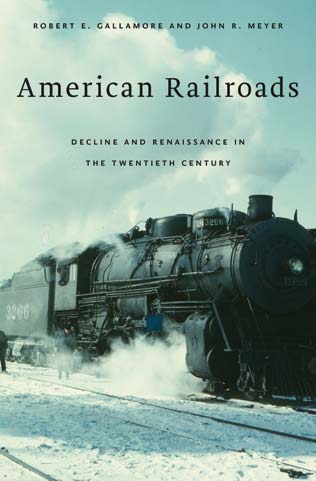Return to George W. and Constance M. Hilton Book Awards
 American Railroads book cover (24K) |
The George W. and Constance M. Hilton Book Award is given for an outstanding work of lasting value to the interpretation of North America’s railroading history. The 2016 award went to Robert E. Gallamore and John W. Meyer, authors of American Railroads: Decline and Renaissance in the Twentieth Century (Harvard University Press, 2014). Meyer (1927-2009) was James W. Harpel Professor of Capital Formation Emeritus at the John F. Kennedy School of Government at Harvard University. Gallamore studied under Meyer and received a doctorate from Harvard University. He retired from Union Pacific Railroad in 2001 (strategic planning and service reliability) to become Director of the Transportation Center and Professor in the Kellogg School of Management at Northwestern University until retirement in 2006. Since 2007, he has been Adjunct Professor in the Rail Management Program at Michigan State University. Earlier in his career, Gallamore was System Plan Coordinator for the United States Railway Association and Deputy Federal Railroad Administrator in the Carter Administration.
The book is mostly chronological, starting early in the 20th Century with Populist-era ICC regulation and Teddy Roosevelt’s big antitrust stick. After dissolution of Hill’s Northern Securities in 1904 and Harriman’s combined UP-SP-IC empire in 1913, the story moves to Federal Control (much misunderstood) in World War I, and the 1920 Transportation Act’s naïve effort to consolidate hundreds of closely-regulated railroads into a score of “balanced” systems. No decades of the century saw less merger activity than those under the Act of 1920, the Great Depression, and World War II. Mergers re-appeared mid-century, with a wide range of results, including the Penn Central disaster. The book details the U.S. Railway Association’s role in reorganizing the Northeast and setting up Conrail. It then follows the industry’s performance under several pieces of legislation, ending with evaluation of the “final four” mergers (BNSF, UP-SP and the split of Conrail) in the last years of the century. It deals with the bankruptcies, subsidy programs, and redeployment of light density lines to new short line operating companies in many parts of the country. Passenger developments and performance are covered in two chapters, before and after Amtrak. Railroads are often thought to represent old and outmoded technology, but we think advancing technology has been one of the reasons for railroads’ amazing productivity leap in the last two decades of the century. The technology chapter covers it all, organized around the fundamental components of efficient railroads–powerful locomotives, durable track, precisely controlled trains, safely built cars and coaches, and smart operating and control systems. The rail renaissance came after the dark middle ages we remember too well, when railroads hit rock bottom in the bicentennial year–the same as Conrail’s birth. Staggers Rail Act deregulation in 1980 allowed railroads to contract for volumes of freight at rates clearing market demand, moving in efficient unit trains, over track and ROW that sported reinvestment paid for with stronger cash flows, and yielding a side benefit of vastly improved safety. Gallamore and Meyers describe and explain deregulation, because, it is the most important reason for the railroads’ recent success. The book draws some enduring themes and poses a number of challenges for the future, but stops short of speculation beyond fundamental policy principles. The full citation Will appears in Railroad History. |